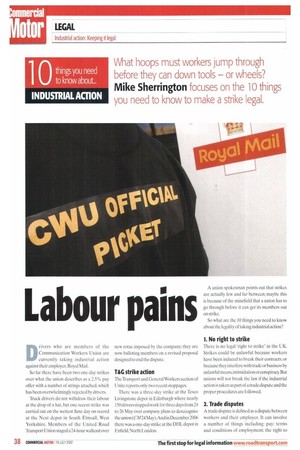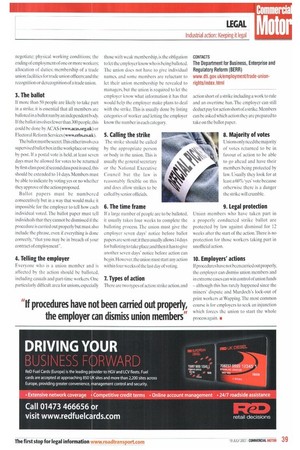Labour pains
Page 38

Page 39

If you've noticed an error in this article please click here to report it so we can fix it.
Drivers who are members of the Communication Workers Union are currently taking industrial action against their employer, Royal Mail.
Sc) far there have been two one-day strikes over what the union describes as a 2.5% pay offer with a number of strings attached, which has been overwhelmingly rejected by drivers.
Truck drivers do not withdraw their labour at the drop of a hat, but one recent strike was carried out on the wettest June day on record at the Next depot in South Elmsall, West Yorkshire. Members of the United Road Transport Union staged a 24-hour walkout over new rotas imposed by the company; they are now balloting members on a revised proposal designed to end the dispute.
T&G strike action The Transport and General Workers section of Unite reports only two recent stoppages.
There was a three-day strike at the Tesco Livingstone depot in Edinburgh where nearly 150 drivers stopped work for three days from 24 to 26 May over company plans to derecognise the union (CM24May).And in December 2006 there was a one-day strike at the DHL depot in Enfield. North London. A union spokesman points out that strikes are actually few and far between; maybe this is because of the minefield that a union has to go through before it can get its members out on strike.
So what are the 10 things you need to know about the legality of taking industrial action?
1. No right to strike There is no legal 'right to strike' in the UK. Strikes could be unlawful because workers have been induced to break their contracts; or because they interfere with trade or business by unlawful means,intimidation or conspiracy. But unions will not break the law if the industrial action is taken as part of a trade dispute and the proper procedures are followed.
2. Trade disputes A trade dispute is defined as a dispute between workers and their employer. It can involve a number of things including: pay: terms and conditions of employment; the right to negotiate: physical working conditions; the ending of employment of one or more workers; allocation of duties; membership of a trade union; facilities for trade union officers; and the recognition or derecognition of a trade union.
3. The ballot If more than 50 people are likely to take part in a strike, it is essential that all members are balloted in a ballot run by an independent body. If the ballot involves fewer than 300 people, this could be done by ACAS (www.acas.org.uk) or Electoral Reform Services (www.erbs.co.uk).
The ballot must be secret,This either involves a supervised ballot box in the workplace or voting by post. If a postal vote is held, at least seven days must he allowed for votes to be returned by first-class post;if second class post is used, this should be extended to 14 days. Members must be able to indicate by voting yes or no whether they approve of the action proposed.
Ballot papers must be numbered consecutively but in a way that would make it impossible for the employer to tell how each individual voted. The ballot paper must tell individuals that they cannot be dismissed if the procedure is carried out properly but must also include the phrase, even if everything is done correctly,that you may be in breach of your contract of employment-.
4. Telling the employer Everyone who is a union member and is affected by the action should be balloted, including casuals and part-time workers. One particularly difficult area for unions, especially those with weak membership, is the obligation to let the employer know who is being balloted. The union does not have to give individual names, and some members are reluctant to let their union membership be revealed to managers, but the union is required to let the employer know what information it has that would help the employer make plans to deal with the strike. This is usually done by listing categories of worker and letting the employer know the number in each category.
5. Calling the strike The strike should be called by the appropriate person or body in the union. This is usually the general secretary or the National Executive Council but the law is reasonably flexible on this and does allow strikes to be called by senior officials.
6. The time frame If a large number of people are to be balloted, it usually takes four weeks to complete the balloting process. The union must give the employer seven days' notice before ballot papers are sent out; it then usually allows 14 days for balloting to take place; and then it has to give another seven days' notice before action can begin. However, the union must start any action within four weeks of the last day of voting.
7. Types of action There are two types of action:strike action, and action short of a strike including a work to rule and an overtime ban. The employer can still deduct pay for action short of a strike. Members can be asked which action they are prepared to take on the ballot paper.
8. Majority of votes Unions only need the majority of votes returned to be in favour of action to be able to go ahead and have their members being protected by law. Usually they look for at least a 60% 'yes' vote because otherwise there is a danger the strike will crumble.
9. Legal protection Union members who have taken part in a properly conducted strike ballot are protected by law against dismissal for 12 weeks after the start of the action. There is no protection for those workers taking part in unofficial action.
10. Employers' actions If procedures have not been carried outproperly, the employer can dismiss union members and in extreme cases can win control of union funds although this has rarely happened since the miners' dispute and Murdoch's lock-out of print workers at Wapping. The most common course is for employers to seek an injunction which forces the union to start the whole process again. •


























































































































































































